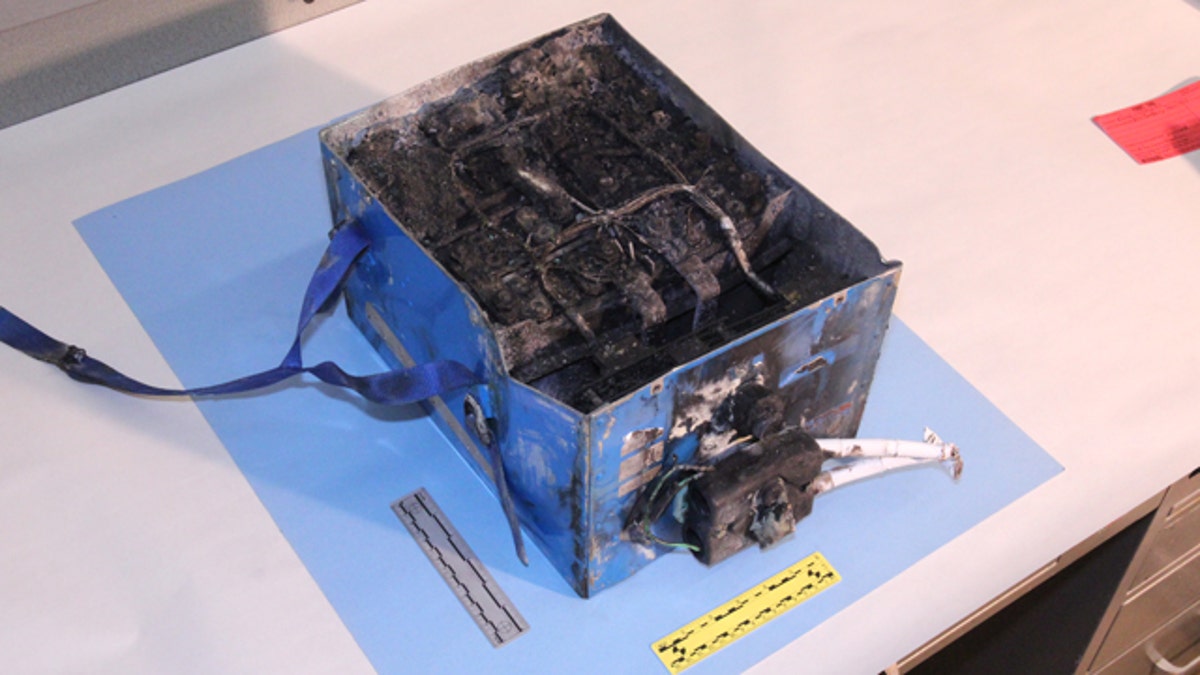
Jan. 7, 2013: This undated image provided by the National Transportation Safety Board shows the burned auxiliary power unit battery from a JAL Boeing 787 that caught fire at Boston's Logan International Airport. (AP)
TOKYO – A battery beneath the cockpit of the Boeing 787 forced to make an emergency landing in Japan was swollen from overheating, a safety official said Thursday, as India joined the U.S. and Japan in grounding the technologically advanced aircraft because of fire risk.
U.S. officials, and a Boeing engineer, are due in Japan on Friday to assist with Japan's investigation into the All Nippon Airways 787 that landed in western Japan after a cockpit message showed battery problems and a burning smell was detected in the cockpit and cabin.
The main battery in an electrical room beneath the cockpit was swollen and had leaked electrolyte, safety inspector Hideyo Kosugi said on Japanese broadcaster NHK. Investigators found burn marks around the battery, though it was not thought to have caught fire.
The 787, known as the Dreamliner, is Boeing's newest jet, and the company is counting heavily on its success. Since its launch after delays of more than three years, the plane has been plagued by a series of problems including a battery fire and fuel leaks.
GS Yuasa Corp., the maker of the lithium ion batteries used in the 787s, said it was helping with the investigation but that the cause of the problem was unclear.
"We still don't know if the problem is with the battery, the power source or the electronics system," said Yasushi Yamamoto, a spokesman the company which is based in Kyoto, Japan. "The cause of the problem is not clear," he said. Thales, which makes the battery charging system, has not commented so far.
Air India's decision Thursday to ground its fleet of six Boeing 787, under orders from Indian aviation authorities, means that some 36 of the 50 jets in use around the world are now out of action. Japan's ANA, which has 17 of the 787s and Japan Airlines, which has seven, voluntarily halted flights Wednesday after the emergency landing but aviation authorities have now made the grounding an official directive.
In Washington, the Federal Aviation Administration also required U.S. carriers to stop flying 787s until the batteries are demonstrated to be safe. United Airlines has six of the jets and is the only U.S. carrier flying the model. Aviation authorities in other countries usually follow the lead of the country where the manufacturer is based.
Yasuo Ishii, an official with the aviation safety division of Japan's transport ministry, said Japan Airlines and ANA had been directed not to fly their 787s until questions over safety of the aircraft are resolved.
The 787 relies more than any other modern airliner on electrical signals to help power nearly everything the plane does. It's also the first Boeing plane to use rechargeable lithium ion batteries for its main electrical system. The batteries charge faster and can be molded to space-saving shapes compared to other airplane batteries, allowing the use of lightweight composite materials instead of aluminum.
Worries over potential fire risks from lithium ion batteries, with their well-known flammability, predate the launch of the 787. In a May 2011 report, the FAA outlined various improvements in containing and preventing onboard fires but also noted that electrolyte leaks could make a fire more hazardous due to the high energy density and power capacity of such batteries.
The FAA had issued special precautions for installation of such batteries on board the 787s.
Boeing said it was working around the clock with investigators.
"We are confident the 787 is safe, and we stand behind its overall integrity," Jim McNerney, company chairman, president and CEO said in a statement.
Japan's transport ministry categorized Wednesday's problem as a "serious incident" that could have led to an accident.
It was unclear how long the Dreamliners would be grounded. ANA and JAL canceled some flights or switched aircraft. Other airlines with 787s in their fleets include Qatar Airways, Ethiopian Airlines, LAN Airlines and LOT Polish Airlines.
Japan's transport ministry had already started a separate inspection Monday of a 787 operated by Japan Airlines that had leaked fuel in Tokyo and Boston, where the flight originated.
A fire ignited Jan. 7 in the battery pack of an auxiliary power unit of an empty Japan Airlines 787 on the tarmac in Boston. It took firefighters 40 minutes to put out the blaze.
A computer problem, a minor fuel leak and a cracked windscreen in a cockpit were also reported on a 787 in Japan this month.
Boeing has said that various technical problems are to be expected in the early days of any aircraft model.
Much remains uncertain about the problems being experienced by the 787, said Masaharu Hirokane, analyst at Nomura Securities Co. in Tokyo.
"You need to ensure safety 100 percent, and then you also have to get people to feel that the jet is 100 percent safe," Hirokane said.
